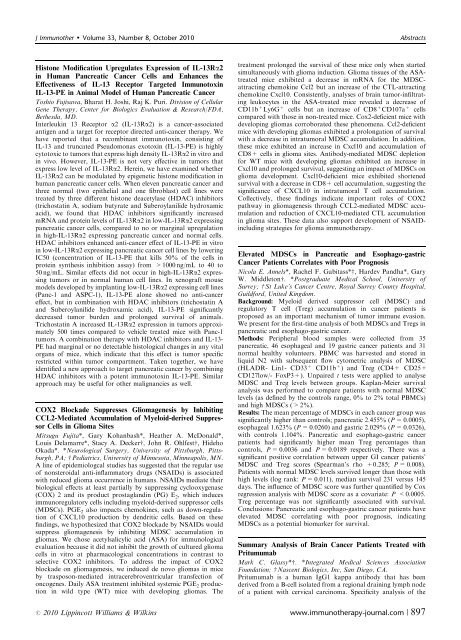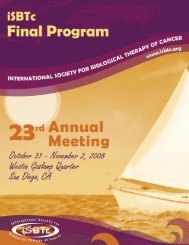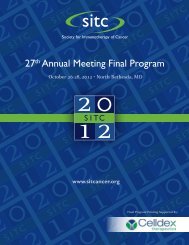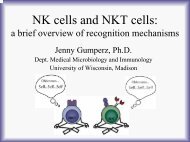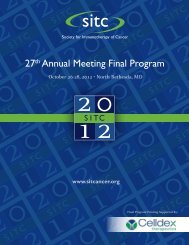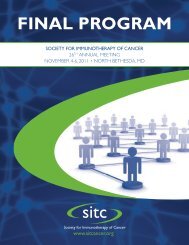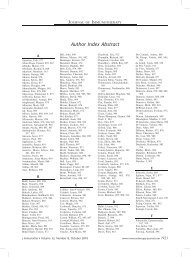Abstracts for the 25th Annual Scientific Meeting of the International ...
Abstracts for the 25th Annual Scientific Meeting of the International ...
Abstracts for the 25th Annual Scientific Meeting of the International ...
Create successful ePaper yourself
Turn your PDF publications into a flip-book with our unique Google optimized e-Paper software.
J Immuno<strong>the</strong>r Volume 33, Number 8, October 2010<br />
<strong>Abstracts</strong><br />
Histone Modification Upregulates Expression <strong>of</strong> IL-13Ra2<br />
in Human Pancreatic Cancer Cells and Enhances <strong>the</strong><br />
Effectiveness <strong>of</strong> IL-13 Receptor Targeted Immunotoxin<br />
IL-13-PE in Animal Model <strong>of</strong> Human Pancreatic Cancer<br />
Toshio Fujisawa, Bharat H. Joshi, Raj K. Puri. Division <strong>of</strong> Cellular<br />
Gene Therapy, Center <strong>for</strong> Biologics Evaluation & Research/FDA,<br />
Be<strong>the</strong>sda, MD.<br />
Interleukin 13 Receptor a2 (IL-13Ra2) is a cancer-associated<br />
antigen and a target <strong>for</strong> receptor directed anti-cancer <strong>the</strong>rapy. We<br />
have reported that a recombinant immunotoxin, consisting <strong>of</strong><br />
IL-13 and truncated Pseudomonas exotoxin (IL-13-PE) is highly<br />
cytotoxic to tumors that express high density IL-13Ra2 in vitro and<br />
in vivo. However, IL-13-PE is not very effective in tumors that<br />
express low level <strong>of</strong> IL-13Ra2. Herein, we have examined whe<strong>the</strong>r<br />
IL-13Ra2 can be modulated by epigenetic histone modification in<br />
human pancreatic cancer cells. When eleven pancreatic cancer and<br />
three normal (two epi<strong>the</strong>lial and one fibroblast) cell lines were<br />
treated by three different histone deacetylase (HDAC) inhibitors<br />
(trichostatin A, sodium butyrate and Suberoylanilide hydroxamic<br />
acid), we found that HDAC inhibitors significantly increased<br />
mRNA and protein levels <strong>of</strong> IL-13Ra2 in low-IL-13Ra2 expressing<br />
pancreatic cancer cells, compared to no or marginal upregulation<br />
in high-IL-13Ra2 expressing pancreatic cancer and normal cells.<br />
HDAC inhibitors enhanced anti-cancer effect <strong>of</strong> IL-13-PE in vitro<br />
in low-IL-13Ra2 expressing pancreatic cancer cell lines by lowering<br />
IC50 (concentration <strong>of</strong> IL-13-PE that kills 50% <strong>of</strong> <strong>the</strong> cells in<br />
protein syn<strong>the</strong>sis inhibition assay) from >1000 ng/mL to 40 to<br />
50 ng/mL. Similar effects did not occur in high-IL-13Ra2 expressing<br />
tumors or in normal human cell lines. In xenograft mouse<br />
models developed by implanting low-IL-13Ra2 expressing cell lines<br />
(Panc-1 and ASPC-1), IL-13-PE alone showed no anti-cancer<br />
effect, but in combination with HDAC inhibitors (trichostatin A<br />
and Suberoylanilide hydroxamic acid), IL-13-PE significantly<br />
decreased tumor burden and prolonged survival <strong>of</strong> animals.<br />
Trichostatin A increased IL-13Ra2 expression in tumors approximately<br />
500 times compared to vehicle treated mice with Panc-1<br />
tumors. A combination <strong>the</strong>rapy with HDAC inhibitors and IL-13-<br />
PE had marginal or no detectable histological changes in any vital<br />
organs <strong>of</strong> mice, which indicate that this effect is tumor specific<br />
restricted within tumor compartment. Taken toge<strong>the</strong>r, we have<br />
identified a new approach to target pancreatic cancer by combining<br />
HDAC inhibitors with a potent immunotoxin IL-13-PE. Similar<br />
approach may be useful <strong>for</strong> o<strong>the</strong>r malignancies as well.<br />
COX2 Blockade Suppresses Gliomagenesis by Inhibiting<br />
CCL2-Mediated Accumulation <strong>of</strong> Myeloid-derived Suppressor<br />
Cells in Glioma Sites<br />
Mitsugu Fujita*, Gary Kohanbash*, Hea<strong>the</strong>r A. McDonald*,<br />
Louis Delamarre*, Stacy A. Deckerw, John R. Ohlfestw, Hideho<br />
Okada*. *Neurological Surgery, University <strong>of</strong> Pittsburgh, Pittsburgh,<br />
PA; w Pediatrics, University <strong>of</strong> Minnesota, Minneapolis, MN.<br />
A line <strong>of</strong> epidemiologcal studies has suggested that <strong>the</strong> regular use<br />
<strong>of</strong> nonsteroidal anti-inflammatory drugs (NSAIDs) is associated<br />
with reduced glioma occurrence in humans. NSAIDs mediate <strong>the</strong>ir<br />
biological effects at least partially by suppressing cyclooxygenase<br />
(COX) 2 and its product prostaglandin (PG) E 2 , which induces<br />
immunoregulatory cells including myeloid-derived suppressor cells<br />
(MDSCs). PGE 2 also impacts chemokines, such as down-regulation<br />
<strong>of</strong> CXCL10 production by dendritic cells. Based on <strong>the</strong>se<br />
findings, we hypo<strong>the</strong>sized that COX2 blockade by NSAIDs would<br />
suppress gliomagenesis by inhibiting MDSC accumulation in<br />
gliomas. We chose acetylsalicylic acid (ASA) <strong>for</strong> immunological<br />
evaluation because it did not inhibit <strong>the</strong> growth <strong>of</strong> cultured glioma<br />
cells in vitro at pharmacological concentrations in contrast to<br />
selective COX2 inhibitors. To address <strong>the</strong> impact <strong>of</strong> COX2<br />
blockade on gliomagenesis, we induced de novo gliomas in mice<br />
by trasposon-mediated intracerebroventricular transfection <strong>of</strong><br />
oncogenes. Daily ASA treatment inhibited systemic PGE 2 production<br />
in wild type (WT) mice with developing gliomas. The<br />
treatment prolonged <strong>the</strong> survival <strong>of</strong> <strong>the</strong>se mice only when started<br />
simultaneously with glioma induction. Glioma tissues <strong>of</strong> <strong>the</strong> ASAtreated<br />
mice exhibited a decrease in mRNA <strong>for</strong> <strong>the</strong> MDSCattracting<br />
chemokine Ccl2 but an increase <strong>of</strong> <strong>the</strong> CTL-attracting<br />
chemokine Cxcl10. Consistently, analyses <strong>of</strong> brain tumor-infiltrating<br />
leukocytes in <strong>the</strong> ASA-treated mice revealed a decrease <strong>of</strong><br />
CD11b + Ly6G + cells but an increase <strong>of</strong> CD8 + CD107a + cells<br />
compared with those in non-treated mice. Cox2-deficient mice with<br />
developing gliomas corroborated <strong>the</strong>se phenomena. Ccl2-deficient<br />
mice with developing gliomas exhibited a prolongation <strong>of</strong> survival<br />
with a decrease in intratumoral MDSC accumulation. In addition,<br />
<strong>the</strong>se mice exhibited an increase in Cxcl10 and accumulation <strong>of</strong><br />
CD8+ cells in glioma sites. Antibody-mediated MDSC depletion<br />
<strong>for</strong> WT mice with developing gliomas exhibited an increase in<br />
Cxcl10 and prolonged survival, suggesting an impact <strong>of</strong> MDSCs on<br />
glioma development. Cxcl10-deficient mice exhibited shortened<br />
survival with a decrease in CD8+ cell accumulation, suggesting <strong>the</strong><br />
significance <strong>of</strong> CXCL10 in intratumoral T cell accumulation.<br />
Collectively, <strong>the</strong>se findings indicate important roles <strong>of</strong> COX2<br />
pathway in gliomagenesis through CCL2-mediated MDSC accumulation<br />
and reduction <strong>of</strong> CXCL10-mediated CTL accumulation<br />
in glioma sites. These data also support development <strong>of</strong> NSAIDincluding<br />
strategies <strong>for</strong> glioma immuno<strong>the</strong>rapy.<br />
Elevated MDSCs in Pancreatic and Esophago-gastric<br />
Cancer Patients Correlates with Poor Prognosis<br />
Nicola E. Annels*, Rachel F. Gabitass*w, Hardev Pandha*, Gary<br />
W. Middletonw. *Postgraduate Medical School, University <strong>of</strong><br />
Surrey; w St Luke’s Cancer Centre, Royal Surrey County Hospital,<br />
Guild<strong>for</strong>d, United Kingdom.<br />
Background: Myeloid derived suppressor cell (MDSC) and<br />
regulatory T cell (Treg) accumulation in cancer patients is<br />
proposed as an important mechanism <strong>of</strong> tumor immune evasion.<br />
We present <strong>for</strong> <strong>the</strong> first-time analysis <strong>of</strong> both MDSCs and Tregs in<br />
pancreatic and esophago-gastric cancer.<br />
Methods: Peripheral blood samples were collected from 35<br />
pancreatic, 46 esophageal and 19 gastric cancer patients and 31<br />
normal healthy volunteers. PBMC was harvested and stored in<br />
liquid N2 with subsequent flow cytometric analysis <strong>of</strong> MDSC<br />
(HLADR- Lin1- CD33 + CD11b + ) and Treg (CD4+ CD25+<br />
CD127low/- FoxP3+). Unpaired t tests were applied to analyse<br />
MDSC and Treg levels between groups. Kaplan-Meier survival<br />
analysis was per<strong>for</strong>med to compare patients with normal MDSC<br />
levels (as defined by <strong>the</strong> controls range, 0% to 2% total PBMCs)<br />
and high MDSCs (>2%).<br />
Results: The mean percentage <strong>of</strong> MDSCs in each cancer group was<br />
significantly higher than controls; pancreatic 2.455% (P = 0.0005),<br />
esophageal 1.623% (P = 0.0260) and gastric 2.029% (P = 0.0326),<br />
with controls 1.104%. Pancreatic and esophago-gastric cancer<br />
patients had significantly higher mean Treg percentages than<br />
controls, P = 0.0036 and P = 0.0189 respectively. There was a<br />
significant positive correlation between upper GI cancer patients’<br />
MDSC and Treg scores (Spearman’s rho +0.285; P = 0.008).<br />
Patients with normal MDSC levels survived longer than those with<br />
high levels (log rank: P = 0.011), median survival 231 versus 145<br />
days. The influence <strong>of</strong> MDSC score was fur<strong>the</strong>r quantified by Cox<br />
regression analysis with MDSC score as a covariate: P


